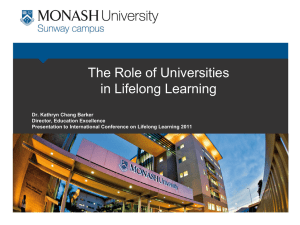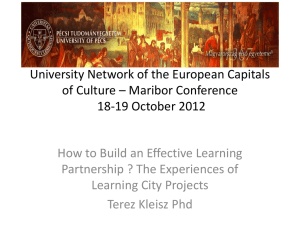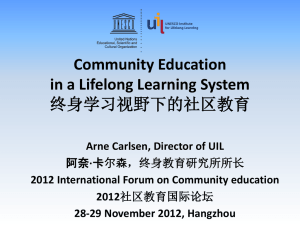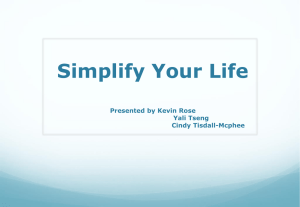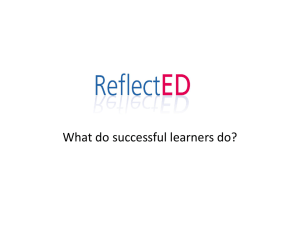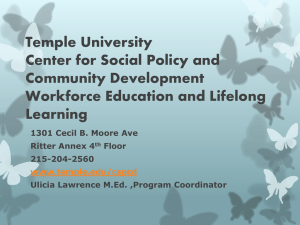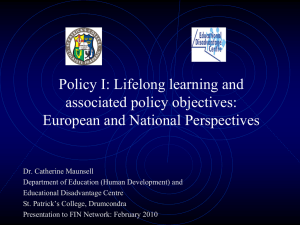Developing Lifelong Learning Strategies, Business Plans and
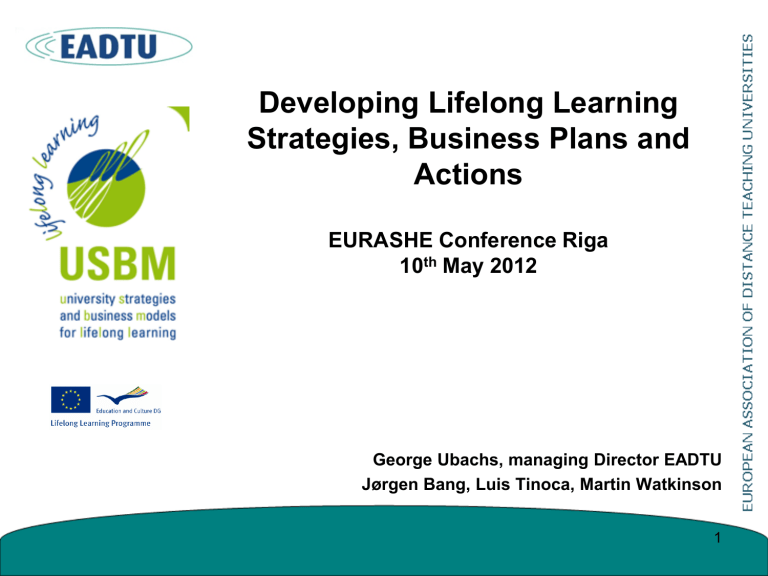
Developing Lifelong Learning
Strategies, Business Plans and
Actions
EURASHE Conference Riga
10 th May 2012
George Ubachs, managing Director EADTU
Jørgen Bang, Luis Tinoca, Martin Watkinson
1
EADTU
EADTU is Europe’s leading representative association for Lifelong Open and Flexible (LOF) learning in distance HE.
Members are:
12 Open and distance teaching Universities
15 Consortia and Associations of conventional universities operating with e-learning and DE
3 Associate members
Representing over 200 Universities and
3 million students.
EADTU’s scope
EADTU initiates activities in the field of:
• Virtual Erasmus (virtual mobility)
• Networked curricula
• Employability (virtual internships)
• Open Educational Resources
• Quality Assurance in e-learning
• Research in LLL
• University Strategies and BM for LLL
USBM: addressing the LLL Challenge
• to develop university strategies and new business models of LLL for 25+ in higher education in Europe.
• to boost lifelong learning in a collaborative setting of conventional universities and distance teaching universities.
• to develop guidelines for institutional strategies and new business models at the local university level based on current best practice, innovative projects and strategies of the partners.
• to raise awareness in the academic community for organising LLL and pave the way for actual changes in institutional strategies.
4
Obstacles for organising LLL
• Government lack of investment/recognition
• Priority of BA/MA and research agenda
• Inadequate offer from HE
• Uncertified commercial offer
• Wide competition between private providers
• Absence of ICT competencies from HE
• Lack of recognition of elearning
• Inadequate infrastructure to support large number of distance education students
Project Partners
Coordinating Institution
European Association of Distance Teaching Universities
EADTU Partner institutions and authors
• Universidade Aberta I PT I
•
The Open University I UK I
• Open Universiteit I NL I
• Universidad Nacional de Educación a Distancia I ES I
• FernUniversität in Hagen I
DE I
• Anadolu University I TR I
• Università Telematica Internazionale UNINETTUNO I
IT I
• Linköping University I SE I
•
Danish Association of Open Universities I DK I
• Katholieke Universiteit Leuven I BE I
•
Lund University I SE I
• Moscow State University of Economics, Statistics and Informatics I RU I
• Fernstudien Schweiz I CH I
6
Triple Track Approach
Formal education : degree education
Non-formal education : customizing flexible education and training to companies and communities
Informal education : sharing of open knowledge; the organisation of open and flexible modules
Universities and national policy makers should be aware that traditional formal education alone cannot meet the challenges of the knowledge society.
Open and flexible distance education to support these concepts.
Organising Lifelong Learning
A demanding supplementary challenge for universities
– to address new target groups,
– shift to new approaches
– change their business models.
This brings forward questions like:
– what target groups to address and how?
– what staff (capacities are) is needed?
– what to offer?
– how to deliver/provide?
– what strategies
– on-campus, off-campus or mixed?
– how to finance this?
9
A University Strategy
• a vision statement - indicating where the institution expects to be in the future and how the operation in planning will contribute.
• a mission statement - explaining what the institution wants to achieve by its operations in general and more specific why and when new operations are started.
• considerations on positioning – governing the relationships of the institution with society, customers/students, suppliers, employees, local community and other stakeholders.
10
Business plan
Strategic planning determines where an organization is going over the next year or more , how it’s going to get there and how it’ll know if it got there or not. The focus of a strategic plan is usually on the entire organization, while the focus of a business plan is usually on a particular product, service or program.
Based of this definition it makes sense to characterize implementation of lifelong learning into a university strategy as a business model. After all lifelong learning is only a part of the overall strategy for a university.
3 operational clusters
1. market relations
– covering customer segment, value propositions, channels and customers relationships,
2. production and delivery
– covering key resources, key activities and key partnerships,
3. financing
– covering revenue streams and cost structure.
12
Market relations
• Do we have courses or programmes that learners outside of our traditional cohort of campus-based students need, or do we have the expertise to create such courses or programmes (a value proposition)?
• Who are the learners and how are they segmented
(customer segments)? How are we going to reach and deliver our courses to these groups of learners
(channels)?
• How do we service the learners (costumer relationships)? Which sort of communicative infrastructure and learning support should be in place for these non-campus-based learners?
13
Considerations
• Demand driven or expertise driven approach
• Install regional university-business platform
• Business approach from within the institutions or outside
• Is a similar course being offered by competing institutions ?
• How many lifelong learners have a need for or an interest in the course and are likely to sign up for it?
• Is it likely that employers will pay the fee or will it have to be paid out of the learner’s own budget?
• Are there requirements that the student has to fulfil before been accepted on the course/programme?
• Does the course require specific language skills?
14
Production and Delivery
• Do we have the key competences in-house ,or do we have to go into partnership with other educational institutions: key partnerships?
• Do we have the communication and service infrastructure in place?
• Are we able to facilitate collaboration and communication among the students and between students and tutors/teachers?
• Make staff familiar with the new pedagogical models?
• How to finance the development of courses/programmes in a period prior to delivery?
• Etc
15
Considerations
• Offering formal – informal – non-formal education
• Flexible, accessible, personalised and interactive
• Does the university have the technological infrastructure and the pedagogical expertise to offer the course as e-learning?
• How much self-produced educational material is it possible to provide for the course?
• Does the course include some hand-on experiments to be carried out in special laboratories?
• How much manpower – professors, lecturers and tutors – will be involved in the delivery of the course and for how many working hours?
• Etc.
16
Financing
• How do we finance the development of lifelong learning courses/programmes – both manpower, material and infrastructure? From which sources do we receive our income (revenue streams)?
• How are our costs distributed (cost structure)? What are the fixed costs – e.g. investment in the production of the course/programme - and what are the variable costs – e.g. expenses for delivery to each student?
How many students do we have to recruit in order to reach a break-even point for revenue and cost – and how many years will it take to reach this point?
17
Considerations
• Is it possible to develop and deliver a course with a high competitive content that fulfils the quality standards of the institution for a price that students/companies are willing to pay?
• Does the programme aim at an audience for whom the fee is irrelevant or of minor importance or even prestigious?
• Does the delivery format place considerable additional costs on the students?
• From which sources does the university receive the funds necessary for providing lifelong learning?
18
Successful BM
HE institutions need the ability not only to identify a market opportunity but also to assess and accommodate the different learning objectives and styles of a diverse group of customers. This means blending different learning materials and teaching styles dependent of the group of learners.
All this in a complex and rapidly changing market
USBM LLL-Guide
Lifelong Learning implementation
GUIDE with references to European
Showcases
http://www.eadtu.eu/lll-portal/
20
Examples of good practices
• Formal:
– The Virtual Environmental Consultancy at OUNL
– The APEL course at OUUK
• Non Formal:
– The Pentalfa programme at K.U. Leuven
– Short courses at UNED
• Informal:
– OER (OUUK, OUNL, UNED, MESI, UAb, Anadolou…)
– Media and museums at Aarhus University
Conclusion
There is no such thing as a singular, definitive strategy and business model that can be generically implemented in all institutions
• Changed (business) models for learning
From formal to non- and informal learning (TRIPLE-Track)
• Changed Student Expectations
Flexible and personalised
• Changed opportunities for academic cooperation
Networked Curricula (NetCu) + Virtual mobility (EPICS)
22
LLL-PRO
Thanks for you attention
George Ubachs
George.ubachs@eadtu.eu
24
